Influence of Reversed Fatigue Loading on Damage Evolution of Cross-Ply Carbon Fibre Composites
Abstract
:1. Introduction
2. Materials and Methods
2.1. Specimen Preparation
2.2. Material Characterisation
2.3. Quasi-Static Testing Procedure
2.4. Fatigue Testing Procedure
3. Results
3.1. Incremental Static Tension Loading
3.2. Crack Opening Displacement Analysis under Reversed Loading
3.3. Evolution of Microcracks in Fatigue
3.4. Delamination Growth during Cyclic Loading
4. Discussion of Results
4.1. Influence of Residual Stresses
4.2. Influence of Load Reversal on Delamination Growth
5. Conclusions
Author Contributions
Funding
Acknowledgments
Conflicts of Interest
References
- Correa, E.; Mantic, V.; Paris, F. A micromechanical view of inter-fibre failure of composite materials under compression transverse to the fibres. Compos. Sci. Technol. 2008, 68, 2010–2021. [Google Scholar] [CrossRef]
- Cuntze, R. Efficient 3D and 2D failure conditions for UD laminae and their application within the verification of the laminate design. Compos. Sci. Technol. 2006, 66, 1081–1096. [Google Scholar] [CrossRef]
- Hashin, Z. Analysis of cracked laminates: A variational approach. Mech. Mater. 1985, 4, 121–136. [Google Scholar] [CrossRef]
- Hinton, M.J.; Kaddour, A.S.; Soden, P.D. Failure Criteria in Fibre Reinforced Polymer Composites: The World-Wide Failure Exercise; Elsevier: Amsterdam, The Netherlands, 2004. [Google Scholar]
- Kaddour, A.; Hinton, M.; Smith, P.; Li, S. The background to the third world-wide failure exercise. J. Compos. Mater. 2013, 47, 2417–2426. [Google Scholar] [CrossRef]
- Kaddour, A.; Hinton, M.; Smith, P.; Li, S. A comparison between the predictive capability of matrix cracking, damage and failure criteria for fibre reinforced composite laminates: Part A of the third world-wide failure exercise. J. Compos. Mater. 2013, 47, 2749–2779. [Google Scholar] [CrossRef]
- Nairn, J.A. Matrix microcracking in composites. Polym. Matrix Compos. 2000, 2, 403–432. [Google Scholar]
- Puck, A. Festigkeitsanalyse von Faser-Matrix-Laminaten - Modelle für die Praxis; Carl Hanser: München, Germany, 1996. [Google Scholar]
- Quaresimin, M.; Carraro, P.A.; Mikkelsen, L.P.; Lucato, N.; Vivian, L.; Brøndsted, P.; Sørensen, B.F.; Varna, J.; Talreja, R. Damage evolution under cyclic multiaxial stress state: A comparative analysis between glass/epoxy laminates and tubes. Compos. Part B Eng. 2014, 61, 282–290. [Google Scholar] [CrossRef]
- Quaresimin, M.; Carraro, P.A.; Maragoni, L. Early stage damage in off-axis plies under fatigue loading. Compos. Sci. Technol. 2016, 128, 147–154. [Google Scholar] [CrossRef]
- Carraro, P.; Quaresimin, M. A stiffness degradation model for cracked multidirectional laminates with cracks in multiple layers. Int. J. Solids Struct. 2015, 58, 34–51. [Google Scholar] [CrossRef]
- Degrieck, J.; Van Paepegem, W. Fatigue damage modeling of fibre-reinforced composite materials: Review. Appl. Mech. Rev. 2001, 54, 279–300. [Google Scholar] [CrossRef]
- Krüger, H.; Rolfes, R. A physically based fatigue damage model for fibre-reinforced plastics under plane loading. Int. J. Fatigue 2015, 70, 241–251. [Google Scholar] [CrossRef]
- Mohammadi, B.; Rohanifar, M.; Salimi-Majd, D.; Farrokhabadi, A. Micromechanical prediction of damage due to transverse ply cracking under fatigue loading in composite laminates. J. Reinf. Plast. Compos. 2017, 36, 377–395. [Google Scholar] [CrossRef]
- Sevenois, R.D.B.; Van Paepegem, W. Fatigue damage modeling techniques for textile composites: Review and comparison with unidirectional composite modeling techniques. Appl. Mech. Rev. 2015, 67, 1–12. [Google Scholar] [CrossRef]
- Bak, B.L.V.; Sarrado, C.; Turon, A.; Costa, J. Delamination Under Fatigue Loads in Composite Laminates: A Review on the Observed Phenomenology and Computational Methods. Appl. Mech. Rev. 2014, 66, 1–24. [Google Scholar] [CrossRef]
- Harris, B. (Ed.) Fatigue in Composites: Science and Technology of the Fatigue Response of Fibre-Reinforced Plastics; CRC Press: Cambridge, CA, USA, 2003. [Google Scholar]
- Gamstedt, E.K.; Sjögren, B. Micromechanisms in tension-compression fatigue of composite laminates containing transverse plies. Compos. Sci. Technol. 1999, 59, 167–178. [Google Scholar] [CrossRef]
- Kardomateas, G.A.; Pelegri, A.A.; Malik, B. Growth of internal delaminations under cyclic compression in composite plates. J. Mech. Phys. Solids 1995, 43, 847–868. [Google Scholar] [CrossRef]
- Kardomateas, G.A.; Malik, B. Fatigue delamination growth under cyclic compression in glass/epoxy composite beam/plates. Polym. Compos. 1997, 18, 169–178. [Google Scholar] [CrossRef]
- Koch, I.; Just, G.; Tittmann, K.; Brod, M.; Jansen, E.; Gude, M.; Rolfes, R. Influence of stress ratio and manufacturing induced residual stresses to fatigue cracking of cfrp. In Proceedings of the 7th International Conference on the Fatigue of Composites, Vicenza, Italy, 4–6 July 2018; p. 9. [Google Scholar]
- Quaresimin, M.; Carraro, P.; Maragoni, L. Influence of load ratio on the biaxial fatigue behaviour and damage evolution in glass/epoxy tubes under tension–torsion loading. Compos. Part A Appl. Sci. Manuf. 2015, 78, 294–302. [Google Scholar] [CrossRef]
- Reifsnider, K.L.; Talug, A. Analysis of fatigue damage in composite laminates. Int. J. Fatigue 1980, 2, 3–11. [Google Scholar] [CrossRef]
- Highsmith, A.L.; Reifsnider, K.L. Stiffness-reduction mechanisms in composite laminates. In Damage in Composite Materials: Basic Mechanisms, Accumulation, Tolerance, and Characterization; ASTM International: West Conshohocken, PA, USA, 1982. [Google Scholar]
- Masters, J.E.; Reifsnider, K.L. An investigation of cumulative damage development in quasi-isotropic graphite/epoxy laminates. In Damage in Composite Materials: Basic Mechanisms, Accumulation, Tolerance, and Characterization; ASTM International: West Conshohocken, PA, USA, 1982. [Google Scholar]
- Crossman, F.W.; Warren, W.J.; Wang, A.S.D.; Law, G.E. Initiation and Growth of Transverse Cracks and Edge Delamination in Composite Laminates Part 2. Experimental Correlation. J. Compos. Mater. 1980, 14, 88–108. [Google Scholar] [CrossRef]
- Crossman, F.W.; Wang, A.S.D. The dependence of transverse cracking and delamination on ply thickness in graphite/epoxy laminates. In Damage in Composite Materials: Basic Mechanisms, Accumulation, Tolerance, and Characterization; ASTM International: West Conshohocken, PA, USA, 1982. [Google Scholar]
- O’Brien, T.K. Characterization of delamination onset and growth in a composite laminate. In Damage in Composite Materials: Basic Mechanisms, Accumulation, Tolerance, and Characterization; ASTM International: West Conshohocken, PA, USA, 1981. [Google Scholar]
- O’Brien, T.K. Analysis of local delaminations and their influence on Composite laminate behavior. In Delamination and Debonding of Materials; ASTM International: West Conshohocken, PA, USA, 1985. [Google Scholar]
- Khan, R.; Alderliesten, R.; Badshah, S.; Benedictus, R. Effect of stress ratio or mean stress on fatigue delamination growth in composites: Critical review. Compos. Struct. 2015, 124, 214–227. [Google Scholar] [CrossRef]
- Tabiei, A.; Zhang, W. Composite Laminate Delamination Simulation and Experiment: A Review of Recent Development. Appl. Mech. Rev. 2018, 70, 1–23. [Google Scholar] [CrossRef]
- Koch, I.; Just, G.; Gude, M. Discussions on the influence of residual stresses to the fatigue of layered polymer composites. In Proceedings of the 2nd International Symposium on Multiscale Experimental Mechanics: Multiscale Fatigue, Lyngby, Denmark, 8–9 November 2017; p. 15. [Google Scholar]
- DIN 527—Kunststoffe—Bestimmung der Zugeigenschaften. Available online: https://www.beuth.de/de/norm/din-en-iso-527-1/147683249 (accessed on 13 March 2018).
- DIN 14126—Bestimmung der Druckeigenschaften in der Laminatebene. Available online: https://www.beuth.de/de/norm/din-en-14126/62482839 (accessed on 13 March 2018).
- DIN 53752—Prüfung von Kunststoffen—Bestimmung des thermischen Längenausdehnungskoeffizienten. Available online: https://www.beuth.de/de/norm/din-53753/898173 (accessed on 7 May 2018).
- DIN 2564—Kohlenstofffaser-Laminate—Bestimmung der Faser-, Harz- und Porenanteile. Available online: https://www.beuth.de/de/norm/din-en-2564/5191401 (accessed on 6 June 2018).
- ASTM D 7078—Standard Test Method for Shear Properties of Composite Materials by V-Notched Rail Shear Method. Available online: https://www.beuth.de/de/norm/astm-d-7078-d-7078m/170840838 (accessed on 18 May 2018).
- Berthelot, J.M.; Le Corre, J.F. Statistical analysis of the progression of transverse cracking and delamination in cross-ply laminates. Compos. Sci. Technol. 2000, 60, 2659–2669. [Google Scholar] [CrossRef]
- Takeda, N.; Ogihara, S. Initiation and growth of delamination from the tips of transverse cracks in CFRP cross-ply laminates. Compos. Sci. Technol. 1994, 52, 309–318. [Google Scholar] [CrossRef]
- Gudmundson, P.; Zang, W. An analytic model for thermoelastic properties of composite laminates containing transverse matrix cracks. Int. J. Solids Struct. 1993, 30, 3211–3230. [Google Scholar] [CrossRef]
- Lundmark, P.; Varna, J. Constitutive Relationships for Laminates with Ply Cracks in In-plane Loading. Int. J. Damage Mech. 2005, 14, 235–259. [Google Scholar] [CrossRef]
- Varna, J.; Berglund, L.; Talreja, R.; Jakovics, A. A Study of the Opening Displacement of Transverse Cracks in Cross-Ply Laminates. Int. J. Damage Mech. 1993, 2, 272–289. [Google Scholar] [CrossRef]
- Varna, J.; Akshantala, N.V.; Talreja, R. Crack Opening Displacement and the Associated Response of Laminates with Varying Constraints. Int. J. Damage Mech. 1999, 8, 174–193. [Google Scholar] [CrossRef]
- Singh, C.V.; Talreja, R. A synergistic damage mechanics approach for composite laminates with matrix cracks in multiple orientations. Mech. Mater. 2009, 41, 954–968. [Google Scholar] [CrossRef]
- Nairn, J.A. The Strain Energy Release Rate of Composite Microcracking: A Variational Approach. J. Compos. Mater. 1989, 23, 1106–1129. [Google Scholar] [CrossRef]
- Brod, M.; Just, G.; Jansen, E.; Koch, I.; Rolfes, R.; Gude, M. Simulation of the fatigue damage behavior of carbon composites under consideration of manufacturing induced residual stresses. In Proceedings of the 7th International Conference on the Fatigue of Composites, Vicenza, Italy, 4–6 July 2018; p. 8. [Google Scholar]
- Bartley-Cho, J.; Gyu Lim, S.; Hahn, H.T.; Shyprykevich, P. Damage accumulation in quasi-isotropic graphite/epoxy laminates under constant-amplitude fatigue and block loading. Compos. Sci. Technol. 1998, 58, 1535–1547. [Google Scholar] [CrossRef]
- Benzeggagh, M.L.; Kenane, M. Measurement of mixed-mode delamination fracture toughness of unidirectional glass/epoxy composites with mixed-mode bending apparatus. Compos. Sci. Technol. 1996, 56, 439–449. [Google Scholar] [CrossRef]
- Kenane, M.; Benzeggagh, M.L. Mixed-mode delamination fracture toughness of unidirectional glass/epoxy composites under fatigue loading. Compos. Sci. Technol. 1997, 57, 597–605. [Google Scholar] [CrossRef]
- Wevers, M.; Verpoest, I.; De Meester, P. Is crack closure due to fatigue loading causing more damage in carbon fibre reinforced epoxy composites? In Developments in the Science and Technology of Composite Materials; Füller, J., Grüninger, G., Schulte, K., Bunsell, A.R., Massiah, A., Eds.; Elsevier: Stuttgart, Germany, 1990; pp. 181–188. [Google Scholar]

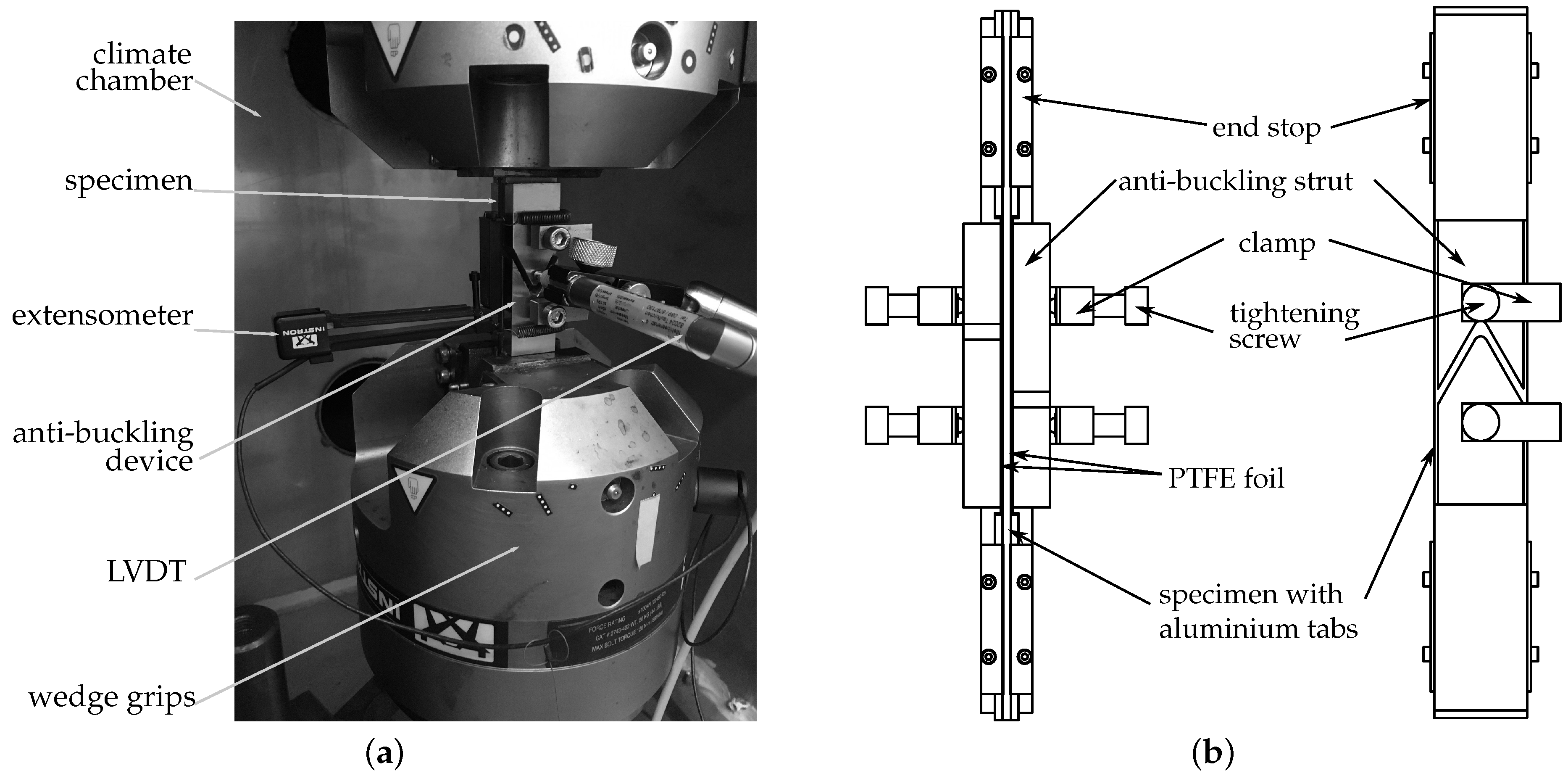
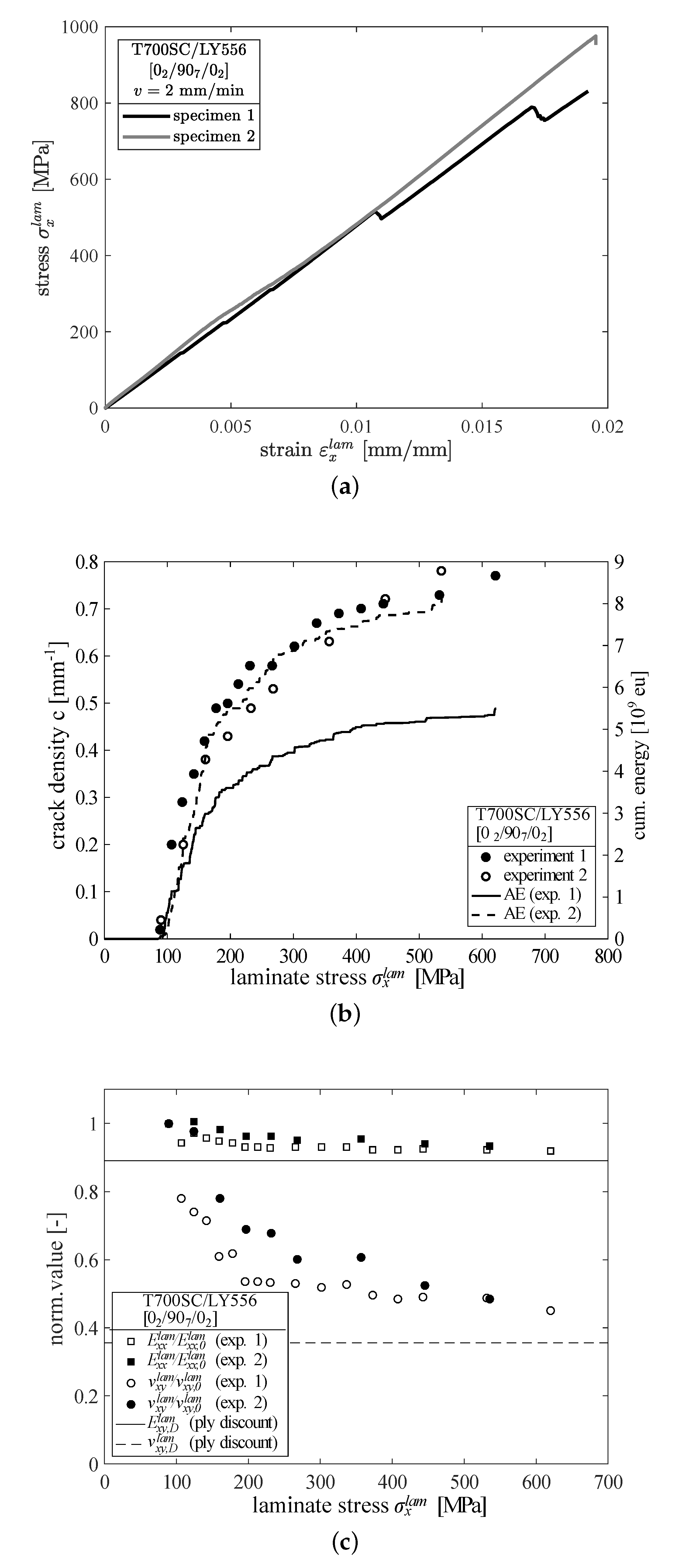
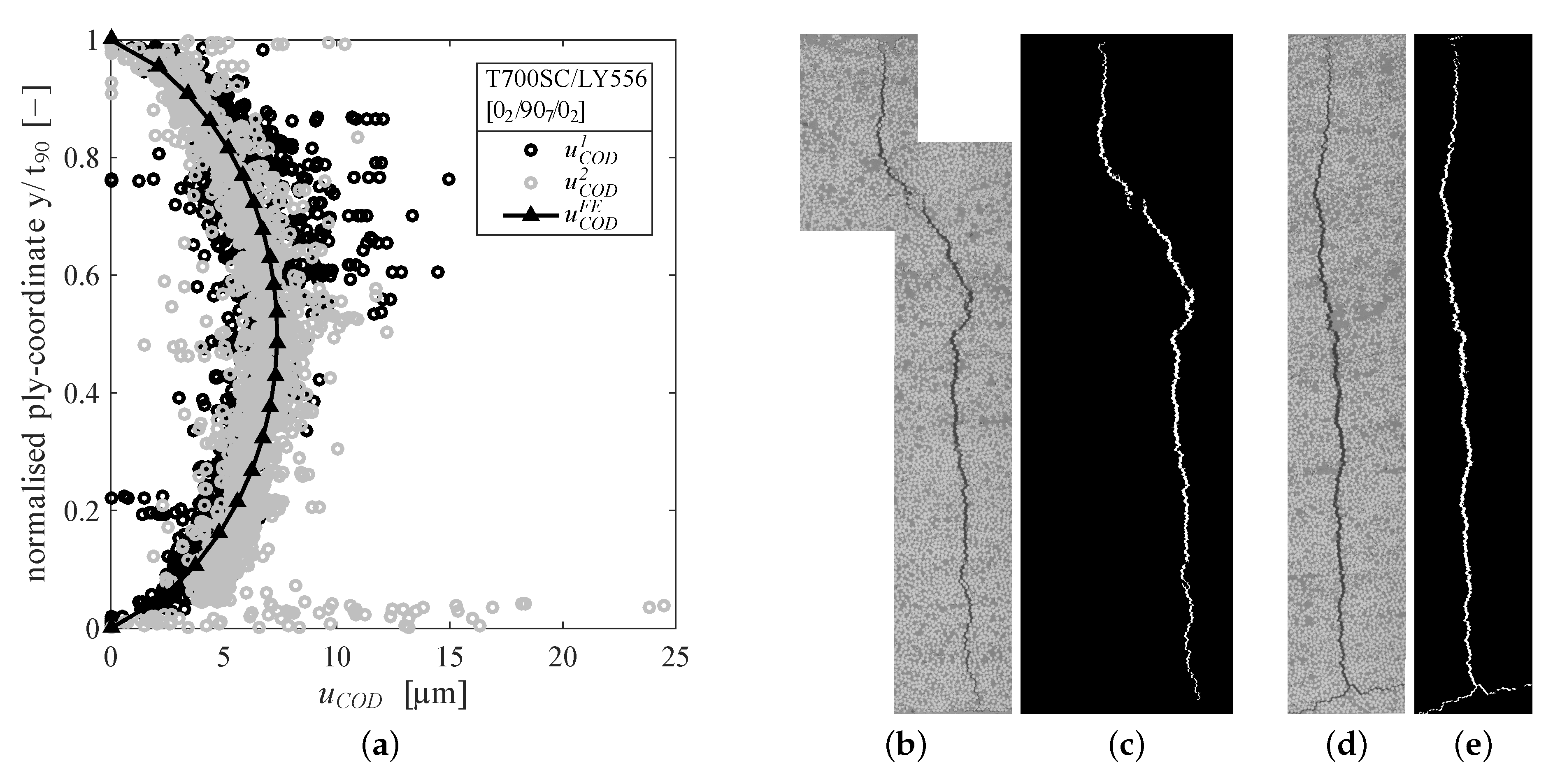
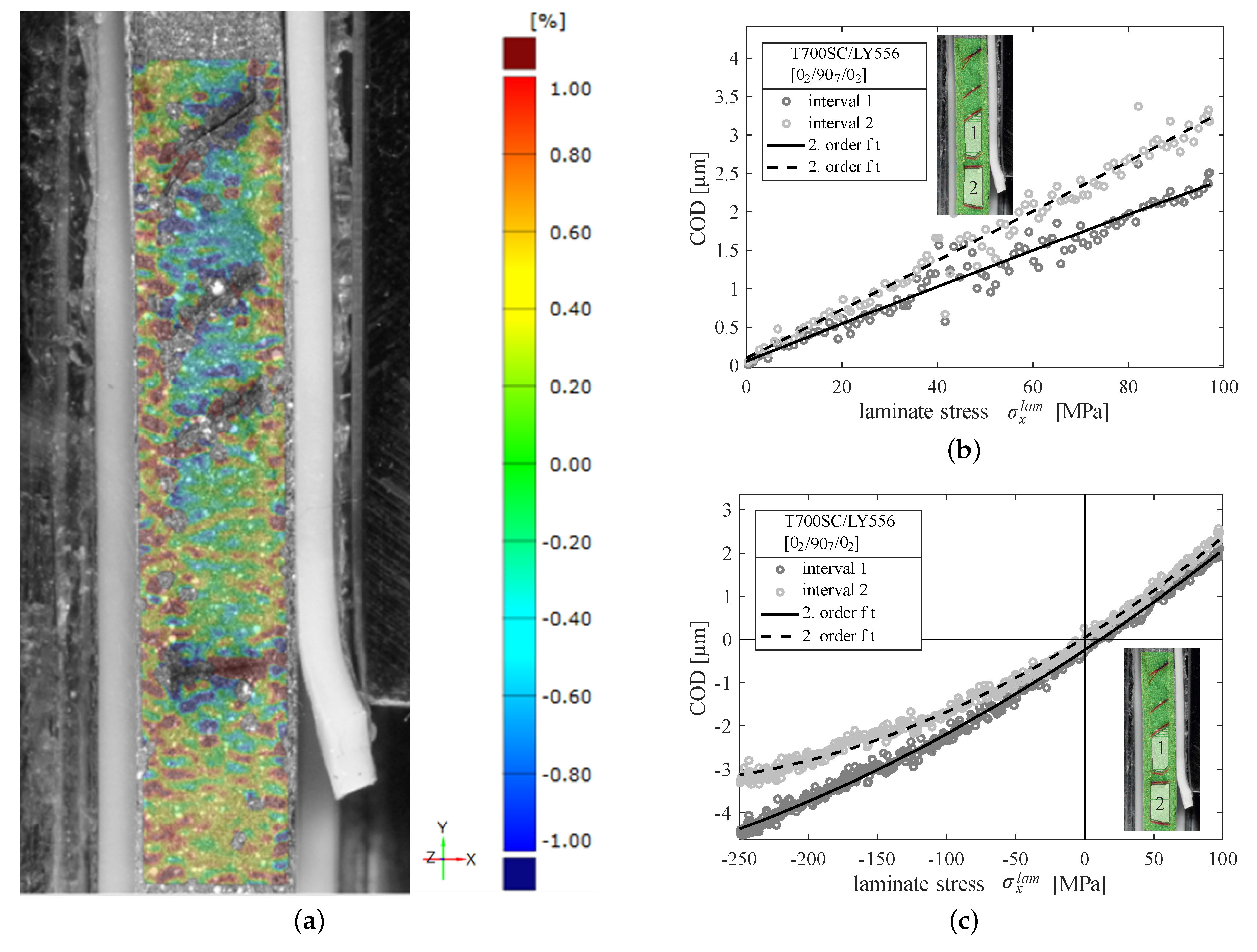
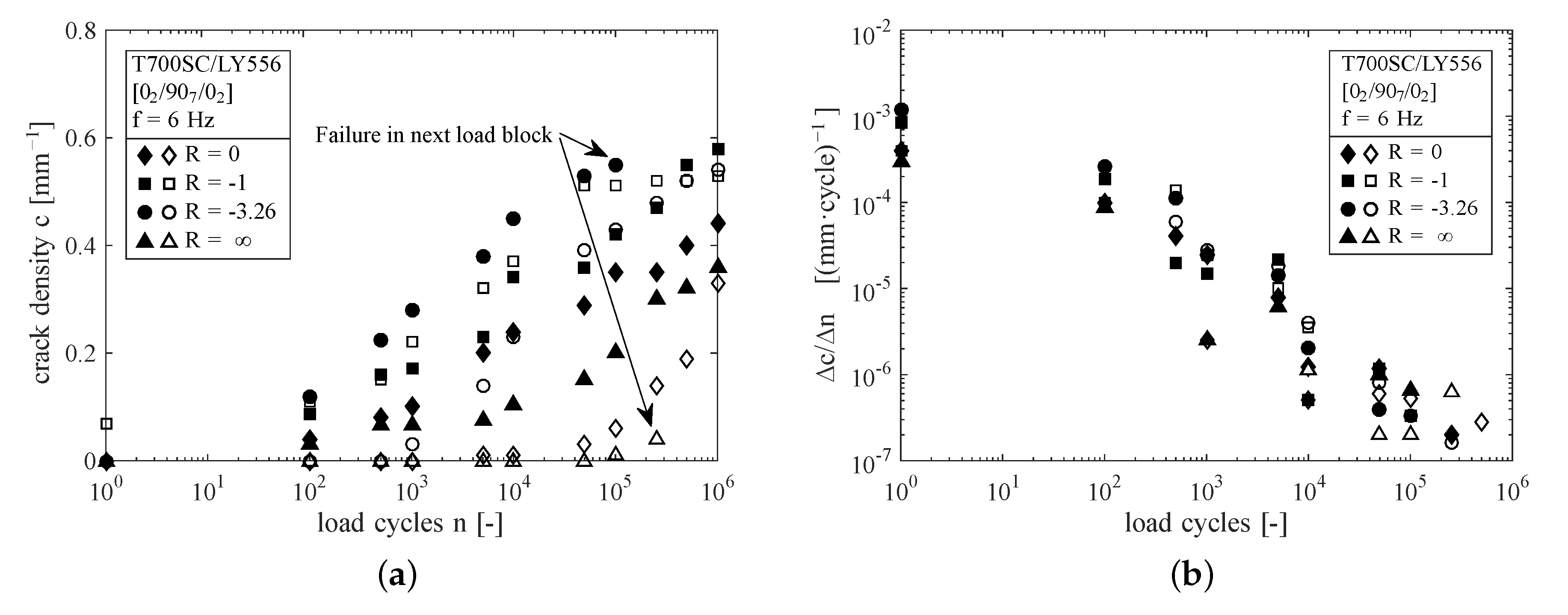
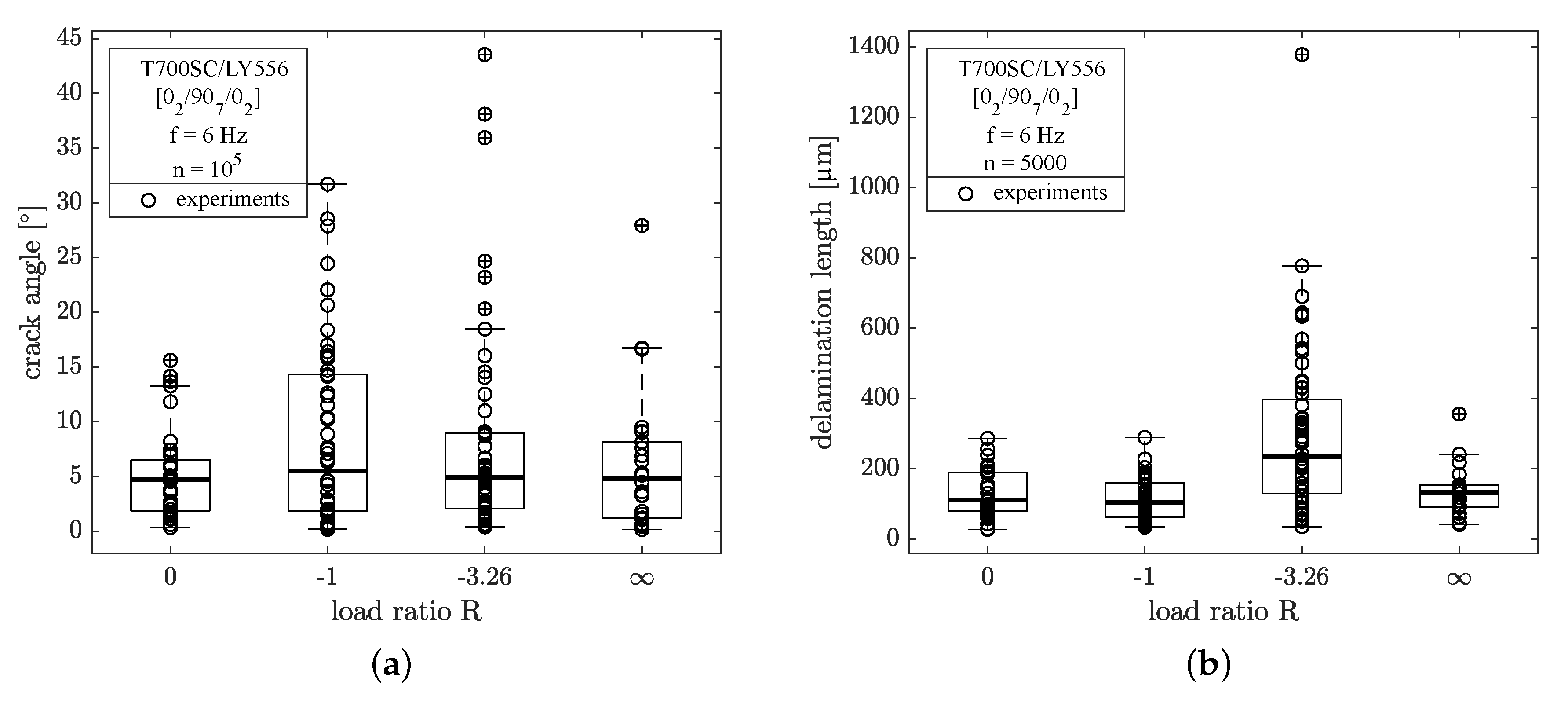



| [GPa] | [GPa] | [GPa] | [GPa] | [GPa] | [GPa] | [−] | [−] |
|---|---|---|---|---|---|---|---|
| − | |||||||
| [MPa] | [MPa] | [MPa] | [MPa] | [MPa] | [K] | [K] | [C] |
| 2089 | 1032 | 38 | |||||
| − | − |
| Parameter | Value | Units |
|---|---|---|
| Sample rate | 10 | |
| Threshold | 46 | dB |
| Gain | 34 | dB |
| Duration Discrimination Time | 0.2 | |
| Rearm Time | 0.4 |
| No. | R | ||||
|---|---|---|---|---|---|
| [MPa] | [MPa] | [MPa] | [MPa] | ||
| 1 | 0 | 105 | 0 | 52.5 | 52.5 |
| 2 | 0 | 100 | 0 | 50 | 50 |
| 3 | −1 | 105 | −105 | 0 | 105 |
| 4 | −1 | 100 | −100 | 0 | 100 |
| 5 | −3.26 | 105 | −342.3 | −118.7 | 223.65 |
| 6 | −3.26 | 100 | −326 | −113 | 213 |
| 7 | ∞ | 0 | −380 | −190 | 190 |
| 8 | ∞ | 0 | −400 | −200 | 200 |
| R | Data Sets | No. | |||
|---|---|---|---|---|---|
| [] | [ ] | [ ] | |||
| 0 | 24 | 0 | |||
| 18 | 2 | ||||
| 38 | * | 21 | |||
| ∞ | 12 | 6 |
| No. | R | |||||
|---|---|---|---|---|---|---|
| [MPa] | [MPa] | [MPa] | [MPa] | |||
| 1 | 0 | 42.4 | 25.7 | 34.1 | 8.3 | 0.61 |
| 2 | 0 | 41.6 | 25.7 | 33.7 | 7.9 | 0.62 |
| 3 | −1 | 42.4 | 8.9 | 25.6 | 16.8 | 0.21 |
| 4 | −1 | 41.6 | 9.8 | 25.7 | 15.9 | 0.24 |
| 5 | −3.26 | 42.4 | −28.9 | 6.8 | 35.6 | −0.68 |
| 6 | −3.26 | 41.6 | −26.3 | 7.7 | 33.9 | −0.63 |
| 7 | ∞ | 25.7 | −34.9 | −4.6 | 30.3 | −1.36 |
| 8 | ∞ | 25.7 | −38.1 | −6.2 | 31.9 | −1.48 |
© 2019 by the authors. Licensee MDPI, Basel, Switzerland. This article is an open access article distributed under the terms and conditions of the Creative Commons Attribution (CC BY) license (http://creativecommons.org/licenses/by/4.0/).
Share and Cite
Just, G.; Koch, I.; Brod, M.; Jansen, E.; Gude, M.; Rolfes, R. Influence of Reversed Fatigue Loading on Damage Evolution of Cross-Ply Carbon Fibre Composites. Materials 2019, 12, 1153. https://doi.org/10.3390/ma12071153
Just G, Koch I, Brod M, Jansen E, Gude M, Rolfes R. Influence of Reversed Fatigue Loading on Damage Evolution of Cross-Ply Carbon Fibre Composites. Materials. 2019; 12(7):1153. https://doi.org/10.3390/ma12071153
Chicago/Turabian StyleJust, Gordon, Ilja Koch, Martin Brod, Eelco Jansen, Maik Gude, and Raimund Rolfes. 2019. "Influence of Reversed Fatigue Loading on Damage Evolution of Cross-Ply Carbon Fibre Composites" Materials 12, no. 7: 1153. https://doi.org/10.3390/ma12071153





